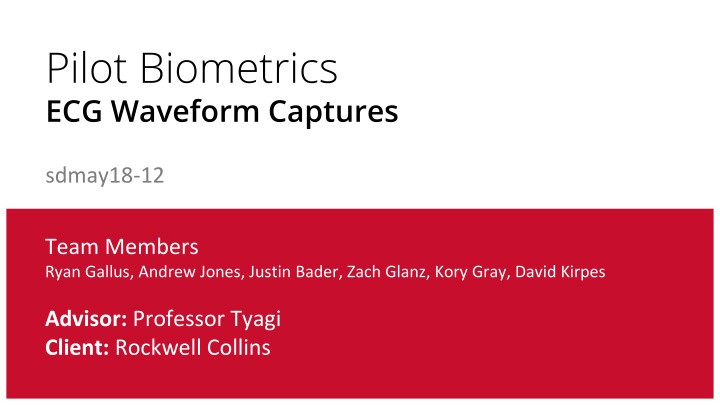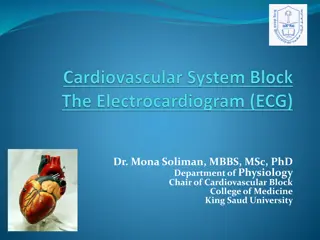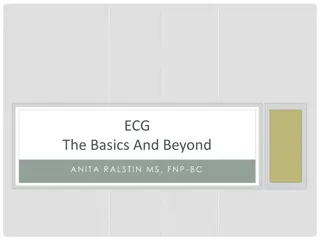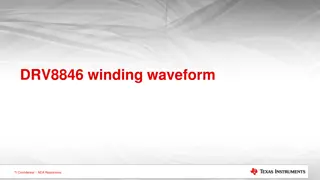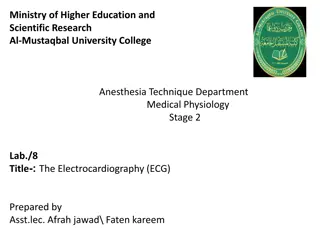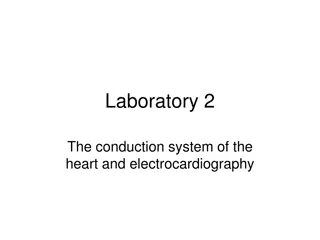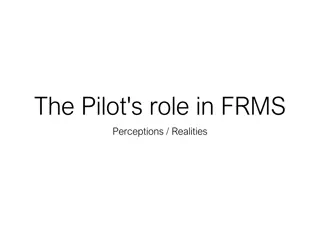Pilot Biometrics ECG Waveform Monitoring for US Navy Pilots
Providing critical medical information to decision-makers about the condition of US Navy pilots during training missions, the project captures, monitors, and analyzes Electrocardiograph (ECG) waveforms. ECG sensors attached to pilots via disposable pads under flight suits in the challenging operational environment of military aircraft cockpits. The data collected assists in stress detection, heart rate variability measurements, and identifying early health issues, benefiting both training and health officers in real-time decision-making.
Download Presentation

Please find below an Image/Link to download the presentation.
The content on the website is provided AS IS for your information and personal use only. It may not be sold, licensed, or shared on other websites without obtaining consent from the author.If you encounter any issues during the download, it is possible that the publisher has removed the file from their server.
You are allowed to download the files provided on this website for personal or commercial use, subject to the condition that they are used lawfully. All files are the property of their respective owners.
The content on the website is provided AS IS for your information and personal use only. It may not be sold, licensed, or shared on other websites without obtaining consent from the author.
E N D
Presentation Transcript
Pilot Biometrics ECG Waveform Captures sdmay18-12 Team Members Ryan Gallus, Andrew Jones, Justin Bader, Zach Glanz, Kory Gray, David Kirpes Advisor: Professor Tyagi Client: Rockwell Collins
Purpose Provide critical medical information to decision makers about the condition of US Navy pilots during training missions
Project Overview Capture, monitor, and analyze Electrocardiograph (ECG) waveform Three ECG Sensors take voltage readings Filtering remove interference noise Analog to Digital Converter (ADC) converts signals ECG waveform data fed into microcontroller Copy stored on device (4-5 hours) Copy packaged for output Input into artificial neural network for stress detection Battery and voltage regulator for 4-5 hours operation
Operational Environment ECG sensors attached to user via disposable pads under flight suit Used inside military aircraft cockpit Rough shaking Inconsistent vibrations Movements from pilot Unpredictable muscle contractions High-g maneuvers Pressurized cabin Reasonable range of temperatures and humidity
Intended Users US Navy fighter pilots in training Pilots already certified to operate aircraft In good health and physical condition Practicing missions with multiple aircraft Extracted data can be transmitted to ground in real time Data used by training and health officers Determine whether or not to continue mission Confirm if pilot is fit to continue training Identify health issues early
ECG Waveform Captured using 3-Leads R-Wave Used to detect Heart-Rate Easy to capture QT Interval Time from start of R-wave to the end of T-wave Not as reliable to capture
Detecting Stress Heart-Rate Variability Measure variability between R-waves Easily Implemented with ECG High variability is indicator of stress QT Interval Measurement of QT intervals Difficult to implement accurately Decreased interval indicates stress
Hardware ADS1298R (Pictured) 24-bit ADC Built in hardware frequency filter Nucleo-144 (Pictured) Used in place of permanent microcontroller Communicates over SPI ECG Leads (Pictured) STM32F746G Discovery
Voltage Regulator & Battery Voltage Regulator Power Cord Battery Vin(9V) Ground Ground Vout Vout(5V )
Filters Bandpass Filter Notch Filter Offset Voltage
Analog to Digital Converter 24-bit ADC Communication with microcontroller over SPI Operating at 8,000 samples-per-second Using 3 leads for ECG detection Disposable ECG sensor pads placed on skin Return voltage readings Challenges Evaluation module PCB designed for 12-lead system. Evaluation module designed to work with companion board that is only compatible with Windows XP- 7
Microcontroller SPI Interface with ADC ADC output written to board registers C++ application reads registers and directs data flow STM32F746G Discovery Board Linux Development Environment Reconfigure u-boot and put uClinux on quad-SPI flash memory on board to boot Reconfigure uClinux image to use SPI and store to microSD card
Artificial Neural Network Stress Detection Given a set of training data, will learn whether an individual is stressed or not Uses Heart Rate Variability as the metric to detect cognitive stress Time domain measurement NN50 Can tweek itself over time to with individual pilots
Data Collection Control Data Measuring time between R-waves of user at rest Single task that is uncomplicated Stressed Data Measuring time between R-waves of user doing mentally straining tasks until failure Starts with single spatial navigation task Additional cognitive tasks added until subject feels overly stressed
Testing Component Testing Individually test hardware components Test battery performance/lifetime and data storage requirements ECG Waveform Testing Compare device output against sample ECG data Test on multiple subjects for anomalies Artificial Neural Network Testing Train with labeled data Validate with test data and adjust weights for accuracy
Questions? Team Members Ryan Gallus Andrew Jones Justin Bader Zach Glanz Kory Gray David Kirpes* *Not presenting
